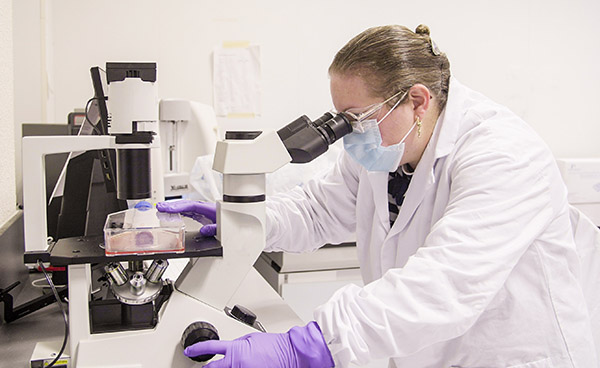Building a Better Tomorrow for All
For decades, vaccines have had an unparalleled impact on global public health and remain one of the most effective methods of preventing infectious diseases worldwide.
This year, the World Health Organization (WHO) selected the theme “Long Life for All” as the focus of its annual observance of World Immunization Week, and for good reason.1 Vaccinations not only help with warding off the likelihood of contracting diseases throughout the lifespan, but also play an important role in helping people live longer lives and experience the important milestones, relationships and fulfillment that come as a result.
Our solutions-oriented approach to vaccine development and deployment at Janssen builds on our legacy of lowering the burden of global health threats like COVID and Ebola,2 helping communities around the globe reach their golden years in good health.
I am thrilled to be working among some of the most talented scientists as we work to address areas where there is still vital work to be done, with the ultimate mission of delivering a vaccine pipeline that is rooted in science and grounded in humanity.
Here are three ways we’re doing this:
Increasing Access Through Global Partnerships. Even the most effective vaccines are only able to succeed when individuals in need can access them when and where they’re needed. Ensuring equitable access to vaccines in the battle against COVID-19 has remained a core pillar of our Company’s pandemic response, with the goal of developing and delivering a vaccine that would help protect the health of everyone, everywhere. To help with increasing access to vaccinations, particularly in low- and lower-middle income countries, we entered into an agreement with the U.S. Government and Gavi, the Vaccine Alliance, to enable access to our COVID-19 vaccine through a novel mechanism to protect the world’s most vulnerable populations. The COVAX Humanitarian Buffer is part of the COVAX Facility and is designed to ensure that people in conflict zones or humanitarian settings can access COVID-19 vaccines, even if they live beyond the reach of traditional, government vaccination campaigns.

Reimagining Solutions for Addressing the Deadliest Global Threats. In the quest for solutions that could greatly improve lives worldwide, we must keep in mind the potential for vaccines to play a key role alongside other public health measures and clinical interventions. For example, a recent analysis from The Lancet showed that infections caused by antimicrobial resistance (AMR) were among the leading causes of death for people of all ages, killing more people worldwide than HIV/AIDS or malaria.3 Yet because of the lack of adequate surveillance of AMR in many parts of the world, the impact is likely to be much larger.
While the focus of AMR is often on curbing the use of antimicrobials in hospitals and other health settings, vaccines can also play an incredibly important role, with their effectiveness spanning a longer period of time and a much lower likelihood of resistance emergence in comparison with antibiotics.4 At Janssen, we have made it a priority to “outpace AMR,” and our Company is one of only a handful prioritizing development of vaccines to protect people from the world’s most deadly bacterial pathogens, including the two leading players in the global AMR crisis — Extraintestinal pathogenic Escherichia coli (ExPEC) and Staphylococcus aureus (S. aureus).4,5 Disease prevention or reduction through vaccination could greatly reduce the use of antibiotics, and consequently, decrease the prevalence of AMR.
Expanding the Definition of “Vaccine-Preventable Diseases.” Finally, while we celebrate the advances we’ve made, we must not lose sight of the fact that what constitutes a “vaccine-preventable disease” is an ever-evolving definition, and advances in science and technology will only expand our vision for what’s possible. A great example of this is respiratory syncytial virus (RSV), a highly contagious respiratory virus affecting more than 64 million people worldwide in a typical year.6 Older adults are among those most at-risk for serious health problems, though no vaccines or antiviral treatments for RSV currently exist.7 With the unmet needs of this population in mind, our Company’s RSV adult vaccine candidate, which has been granted breakthrough therapy designation by the U.S. Food and Drug Administration (FDA) and PRIME designation by the European Medicines Agency (EMA), is currently being studied in adults over 60 years of age to see if it can help this population avoid life-threatening complications like pneumonia, bronchiolitis and bronchitis.
It’s more important than ever to ensure that vaccines remain effective and available, and that we do not lose sight of their potential to have an even greater impact. Our increased understanding of vaccine science, paired with a surge of cutting-edge biotechnology innovation, gives me a tremendous amount of hope and optimism for the future of infectious disease management. By continuing to advance partnerships, explore new solutions and ensure that innovation remains on an upward trajectory, we can remain confident in our ability to build a better tomorrow for all when it comes to infectious disease management, while helping to support people today in remaining healthy into and throughout their golden years.
April 18, 2022
References
- World Immunization Week 2022. (2022). World Health Organization. Accessed March 31, 2022, from https://www.who.int/campaigns/world-immunization-week/world-immunization-week-2022.
- Creating Treatments for Infectious Diseases. (n.d.). Janssen Global Services, LLC. Accessed March 30, 2022, from https://www.janssen.com/infectious-diseases-and-vaccine
- Murray, C. J., et. al. (2022). Global burden of bacterial antimicrobial resistance in 2019: a systematic analysis. The Lancet, 399(10325), 629–655. https://doi.org/10.1016/s0140-6736(21)02724-0
- Micoli, F. et al. (2021). The role of vaccines in combatting antimicrobial resistance. Nature Reviews Microbiology, 19(5), 287–302. https://doi.org/10.1038/s41579-020-00506-3
- World Health Organization. (2017, February 27). WHO publishes list of bacteria for which new antibiotics are urgently needed [Press release]. https://www.who.int/news/item/27-02-2017-who-publishes-list-of-bacteria-for-which-new-antibiotics-are-urgently-needed
- National Institute of Allergy and Infectious Diseases. (2008, December 12). Respiratory Syncytial Virus (RSV). Retrieved March 28, 2022, from https://www.niaid.nih.gov/diseases-conditions/respiratory-syncytial-virus-rsv
- RIVM. (2021, July 21). RS-virus | RIVM. National Institute for Public Health and the Environment. Retrieved March 31, 2022, from https://www.rivm.nl/rs-virus

